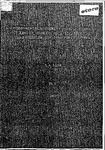ENVIRONMENTAL ASSESSMENT OF BIOGEOCHEMICAL CYCLING OF DISSOLVED ORGANIC CARBON (DOC) AND NITROGEN (DON) IN NATURAL WATERS
| dc.contributor.author | Badr, El-Sayed A. | |
| dc.contributor.other | Faculty of Science and Engineering | en_US |
| dc.date.accessioned | 2012-08-01T13:04:07Z | |
| dc.date.available | 2012-08-01T13:04:07Z | |
| dc.date.issued | 2005 | |
| dc.identifier | Not available | en_US |
| dc.identifier.uri | http://hdl.handle.net/10026.1/1063 | |
| dc.description.abstract |
Increases in human population and activities have lead to significantly enhanced inputs of carbon and nitrogen fiom both point and difiuse sources to rivers, estuaries, and coastal seas, altering the global carbon and nitrogen biogeochemical cycles. This increased load has had a marked ecological impact globally, with detrimental changes to primary production, conununity stricture and water quality. Understandmg the nature and cycling of dissolved organic carbon (DOC) and nitrogen (DON), significant components of the global carbon and nitrogen cycles, in estuaries will provide better estimates of C and N transport to coastal and ocean waters. This study involves: (1) optimisation of the h i ^ temperature catalytic oxidation (HTCO) analytical method used for reliable analysis of DOC and total, dissolved nitrogen (TDN), (2) investigation of spatial and temporal variations of DOC and DON, and other reliated determinands, in two contrasting estuarine environments, the Yealm and Plym, in south-west England, (3) investigation of DON bioavailability using a bacterial incubation experiment, and (4) preliminary work on the use of stable nitrogen isotope ratios to identify DON sources. The sampling and analytical protocols required for rapid, precise and reliable determinations of DOC and DON, using the coupled HTCO-chemiluminescence technique, are described ui this study. This metiiod gave detection limits of approxunately 6.2 \iM C and 0.46 | iM N , and precisions of < 2-3 % and < 3-5 % (n=3-5) for DOC and TDN, respectively. The mean DOC and TDN of the CRMs analysed, over a period of 2 years, were 48 ± 3.9 | iM C and 20 ± 1.5 nM N that were close to the certified values of 44 - 45 pM C and 21 | iM N , respectively. Concentrations of DOC ranged from 61 | iM C at the seaward end to 335 pM C at the fresh water end for the Yealm, and 71 - 290 |j,M C for the Plym. DON concenfrations were mamly m the range of 1.8 - 62 pM N for the Yeahn, and 4-94 \iM N for the Plym. The enhanced DON concenfrations in the Yealm might be the result of sewage discharges and agricultural run off, while in the Plym they may be due to sewage discharge, run off from the Chelson Meadow landfill and other anthropogenic activities within the urban Plym catchment. Except during a limited numbers of surveys, DOC and DON generally behaved in a non conservative manner in these estuaries. Nifrate and filterable reactive phosphate (FRP) behaved relatively conservatively m the Yealm, but were more non-conservative in the Plym. The spatial distribution of DOC and DON concenfrations in the Plym Estuary appeared much more mfluenced by anthropogenic uiputs relative to distributions in the Yealm Estuary. The seasonal variation of DOC and DON was characterised by lower concenfrations during winter and a slight increase in spring and suimner followed by highest concenfrations during late smmner and auturrm, suggesting a sfrong link to seasonally variable phytoplankton production. The confribution of DON to die TDN pool ranged between 4 and 79 % for the Yealm, and 3.5 - 84 % for the Plym. Higher values (53 - 79 %) were observed during late summer, emphasising the important contributions of DON to TDN- pool. Incubation experiments usmg the Plym Estuary water mdicated that 30 - 58 % of DON was bioavailable for heterofrophic bacterial utilisation; at the same time nitrate concentrations increased by 9 - 35 %, presumably through mineralization of DON. From the studies undertaken in the present work, it may be concluded that the omission of DON in estuarine and coastal water studies will result in underestimation of the total nifrogen load. As a significant part of the DON appeared to be bioavailable, ignoring this fraction will result in an underestimation of eutrophication pressures on coastal and ocean waters. | en_US |
| dc.description.sponsorship | Mansoura University, Ministry of Higher Education, Egypt | en_US |
| dc.language.iso | en | en_US |
| dc.publisher | University of Plymouth | en_US |
| dc.subject | DOCTOR OF PHILOSOPHY | en_US |
| dc.title | ENVIRONMENTAL ASSESSMENT OF BIOGEOCHEMICAL CYCLING OF DISSOLVED ORGANIC CARBON (DOC) AND NITROGEN (DON) IN NATURAL WATERS | en_US |
| dc.type | Thesis | |
| dc.identifier.doi | http://dx.doi.org/10.24382/3832 | |
| dc.identifier.doi | http://dx.doi.org/10.24382/3832 |
Files in this item
This item appears in the following Collection(s)
-
01 Research Theses Main Collection
Research Theses Main


